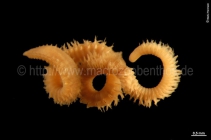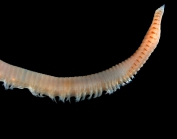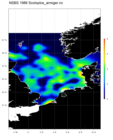
| Introduction | | Search taxa | | Taxon tree | | Taxon match | | Checklist | | Literature | | Stats | | Photogallery | | OBIS Vocab | | Log in |
CaRMS taxon detailsScoloplos Blainville, 1828
129425 (urn:lsid:marinespecies.org:taxname:129425)
accepted
Genus
Scoloplos (Scoloplos) Blainville, 1828 · alternative representation (superseded nominal subgenus)
marine,
recent only
masculine
Blainville, H. M. D de [Henri-Marie Ducrotay]. (1828). Mollusques, Vers et Zoophytes <b>[entries in VEA-VERS, volume 57]</b>. <em>In: Dictionnaire des Sciences naturelles, dans lequel on traite méthodiquement des différens êtres de la nature, considérés soit en eux-memês, d'après l'état actuel de nos connoissances, soit relativement à l'utilité qu'en peuvent retirer la médicine, l'agriculture, le commerce et les arts. Suive d'une biographie des plus célèbres naturalistes.</em> vol. 57 [Tome LVII. Vea - Vers] F.G. Levrault, Strasbourg & Paris., available online at https://biodiversitylibrary.org/page/25316522
page(s): 493 [details]
Etymology Not stated in the original description. The generic name Scoloplos is from the Greek, a masculine word referring to...
Etymology Not stated in the original description. The generic name Scoloplos is from the Greek, a masculine word referring to anything pointed, or a thorn, and might thus refer either to the characteristic pointed head, or to the spiny bristles referred in the original decription: ''Appendices [...] des dix-sept premiers [segments] formés probablement de deux soies épineuses de chaque côté'' (Blainville, 1828: 493). [details] description ORBINIINAE with pointed prostomium and branchiae first present from setiger 5 or later. Accessory papillae never exceeding...
description ORBINIINAE with pointed prostomium and branchiae first present from setiger 5 or later. Accessory papillae never exceeding four, including both ventral and parapodial kinds. Thoracic neurosetae include blunt hooks and crenulated capillaries (may be absent). Abdominal notosetae include crenulated capillaries, furcate setae and spines. [details]
Read, G.; Fauchald, K. (Ed.) (2021). World Polychaeta database. Scoloplos Blainville, 1828. Accessed through: Kennedy, M.K., L. Van Guelpen, G. Pohle, L. Bajona (Eds.) (2021) Canadian Register of Marine Species at: http://www.marinespecies.org/carms/aphia.php?p=taxdetails&id=129425 on 2024-04-24
Nozères, C., Kennedy, M.K. (Eds.) (2024). Canadian Register of Marine Species. Scoloplos Blainville, 1828. Accessed at: https://marinespecies.org/carms/aphia.php?p=taxdetails&id=129425 on 2024-04-24
Date action by
original description
Blainville, H. M. D de [Henri-Marie Ducrotay]. (1828). Mollusques, Vers et Zoophytes <b>[entries in VEA-VERS, volume 57]</b>. <em>In: Dictionnaire des Sciences naturelles, dans lequel on traite méthodiquement des différens êtres de la nature, considérés soit en eux-memês, d'après l'état actuel de nos connoissances, soit relativement à l'utilité qu'en peuvent retirer la médicine, l'agriculture, le commerce et les arts. Suive d'une biographie des plus célèbres naturalistes.</em> vol. 57 [Tome LVII. Vea - Vers] F.G. Levrault, Strasbourg & Paris., available online at https://biodiversitylibrary.org/page/25316522
page(s): 493 [details] taxonomy source Blake, James A. (2017). Polychaeta Orbiniidae from Antarctica, the Southern Ocean, the Abyssal Pacific Ocean, and off South America. <em>Zootaxa.</em> 4218(1): 1-145 [monograph]., available online at http://www.biotaxa.org/Zootaxa/article/view/zootaxa.4218.1.1/25653 page(s): 43; note: genus restricted to species having only inconspicuous spines in thoracic neuropodia accompanied with numerous capillaries, and branchiae from setiger 8–26 [details] Available for editors additional source Fauchald, K. (1977). The polychaete worms, definitions and keys to the orders, families and genera. <em>Natural History Museum of Los Angeles County: Los Angeles, CA (USA), Science Series.</em> 28:1-188., available online at http://www.vliz.be/imisdocs/publications/123110.pdf [details] additional source Bellan, G. (2001). Polychaeta, <i>in</i>: Costello, M.J. <i>et al.</i> (Ed.) (2001). European register of marine species: a check-list of the marine species in Europe and a bibliography of guides to their identification. <em>Collection Patrimoines Naturels.</em> 50: 214-231. (look up in IMIS) [details] additional source Brunel, P., L. Bosse & G. Lamarche. (1998). Catalogue of the marine invertebrates of the estuary and Gulf of St. Lawrence. <em>Canadian Special Publication of Fisheries and Aquatic Sciences, 126.</em> 405 pp. (look up in IMIS) [details] Available for editors additional source Day, J. H. (1967). [Sedentaria] A monograph on the Polychaeta of Southern Africa. Part 2. Sedentaria. British Museum (Natural History), London. pp. 459–842., available online at http://www.biodiversitylibrary.org/bibliography/8596 [details] additional source Glasby, Christopher J.; Read, Geoffrey B.; Lee, Kenneth E.; Blakemore, R.J.; Fraser, P.M.; Pinder, A.M.; Erséus, C.; Moser, W.E.; Burreson, E.M.; Govedich, F.R.; Davies, R.W.; Dawson, E.W. (2009). Phylum Annelida: bristleworms, earthworms, leeches. <em>[Book chapter].</em> Chapt 17, pp. 312-358. in: Gordon, D.P. (Ed.) (2009). New Zealand inventory of biodiversity: 1. Kingdom Animalia: Radiata, Lophotrochozoa, Deuterostomia. Canterbury University Press, Christchurch. [details] Available for editors identification resource Oliveira, Verônica M.; Cutrim, Allana S.T.; Vieira, Anna Karen M.; Ferreira, Camila N.; Almeida, Zafira S.; Nogueira Júnior, Miodeli. (2019). Description of <i>Scoloplos maranhensis</i> sp. nov. (Orbiniidae, Annelida) from tropical Brazilian mangrove. <em>Iheringia, Série Zoologia.</em> 109 (e2019009): 1-10., available online at https://doi.org/10.1590/1678-4766e2019009 page(s): table I; note: synoptic table of currently known species [details] Available for editors  Present Present  Inaccurate Inaccurate  Introduced: alien Introduced: alien  Containing type locality Containing type locality
From editor or global species database
Diagnosis Original diagnosis by Blainville (1828: 493): ''Corps alongé, cylindrique, atténué aux extrémités, et composé d'un grand nombre d'articulations. Bouche et anus terminaux à l'extrémité de segmens non modifiés. Appendices dissemblables. Ceux des dix-sept premiers formés probablement de deux soies épineuses de chaque côté, les autres composés: 1.° D'une sorte de renflement costiforme, proéminent et terminé inférieurement par une verrue bifide; 2.° D'une soie simple et courte; 3.° D'une lamelle lancéolée et arquée.''[details] Etymology Not stated in the original description. The generic name Scoloplos is from the Greek, a masculine word referring to anything pointed, or a thorn, and might thus refer either to the characteristic pointed head, or to the spiny bristles referred in the original decription: ''Appendices [...] des dix-sept premiers [segments] formés probablement de deux soies épineuses de chaque côté'' (Blainville, 1828: 493). [details] Grammatical gender Masculine. Scoloplos is masculine in Greek and most authors have used masculine adjectives with it. [details] From other sources
description ORBINIINAE with pointed prostomium and branchiae first present from setiger 5 or later. Accessory papillae never exceeding four, including both ventral and parapodial kinds. Thoracic neurosetae include blunt hooks and crenulated capillaries (may be absent). Abdominal notosetae include crenulated capillaries, furcate setae and spines. [details]
|



